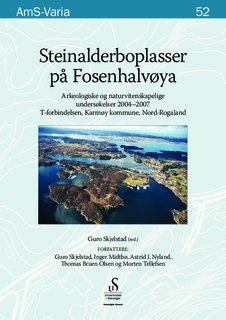| dc.description.abstract | Eleven open-air Stone Age sites, and one rock shelter with multiphase occupation layers, were excavated between 2004 and 2007. These sites are scattered within a limited area on the northern end of the Fosen peninsula, in Karmøy municipality, Northern Rogaland. The distance between the southernmost and northernmost site is about two kilometres. Sites from all phases of the Mesolithic, as well as the Early Neolithic (10 000 to 4700 BP), are present, although six of them date to the Late Mesolithic (7500-
5200 BP).
The investigated area is located in a sheltered, coastal landscape. In the Mesolithic, several east-west oriented streams near the sites provided sea contact between the Karmsund strait and the Boknafjord basin. The Fosen peninsula was, thus, strategically located on an east-west oriented travel route. In addition to communication routes, the streams may have represented nutritious marine environments of special interest to the Mesolithic population. The settlement areas were uncovered by mechanical top-soil stripping in order to explore as much as possible of the past settlements. Many of the sites were situated in sloping and rocky areas, and most of them were of limited size. They were considered well-preserved contexts, as they were expected to have been undisturbed by modern activities. Still, many were more disturbed by natural processes, more than first expected, making analyses of the intra-site activity patterns difficult.
The locations, sizes and tool inventories of the sites indicate differences in function and social organisation. Some of these variations may reflect chronological differences. Of special interest is the process towards settlement stability in Late Mesolithic and Early Neolithic, documented on several other coastal sites in Western Norway. The sites from the latest phase of the Mesolithic in northern Rogaland do show tendencies towards longer, or repeated, occupations. None of the sites are indicating sedentary or semi-sedentary lifestyles, as documented in areas further north. This is also the case for sites from the Early Neolithic in this area. This indicates regional variations in settlement patterns, and probably also lifestyles, in different coastal areas in the southern and western parts of Norway in the Late Mesolithic and Early Neolithic.
Due to the limited number of excavated sites from the Middle Mesolithic in Southern Norway, the two sites from this period have been of special interest in the investigation. Botten 1, in particular, has provided interesting archaeological material from the earliest part of the Middle Mesolithic (MMA), a period previously unexplored in the archaeological record in Rogaland. The results from the project on the Fosen peninsula are seen in light of the results from projects in other parts of coastal western Norway. The Late Mesolithic of Northern Rogaland shows a number of similarities with that of Southern Hordaland and Southern Rogaland. On the other hand, comparing the material with that of areas further north (Nordhordland) and south (Lista) one sees greater differences in tool inventory and in raw material use. Further studies of the excavated material from the Fosen peninsula, seen in a wider perspective, will be useful in order to get a better understanding of regionality and contact networks in the south Western part of Norway in the Mesolithic and the Early Neolithic.
This project is based on both archaeological- and palaeobotanical investigations. Paleobotanical samples have been collected from bogs and lake sediments. Additional samples have been taken inside dwellings and cultural layers in order to obtain information about paleoecology and ancient plant use. The paleobotanical investigations have focused on local shore displacement processes, and the aim has been to develop a more detailed shore displacement curve, particularly focusing on the Preboreal regression minimum and the Tapes transgression maximum. The results indicate a double -peaked Tapes transgression that has several implications for the shore bounded Stone Age sites in the area. The palaeobotanical investigations have also focused on the early human impact on vegetation. Sampling from Rabbavatn indicates that the deforestation process starts in the Middle or Late Neolithic (app. 4000 BP) in the Eastern end of the investigated area, a process connected to the establishment of a more pastoral oriented society. A permanent heathland is established in the same area in the Pre-Roman Iron Age (app. 2100 BP). | nb_NO |
| dc.publisher | Skjelstad, G., Midtbø, I., Nyland, A.J., Olsen, T.B og Tellefsen, M. (2011) Steinalderboplasser på Fosenhalvøya : arkeologiske og naturvitenskapelige undersøkelser 2004-2007 T-forbindelsen, Karmøy kommune, Nord-Rogaland. Stavanger : Arkeologisk museum i Stavanger | nb_NO |
